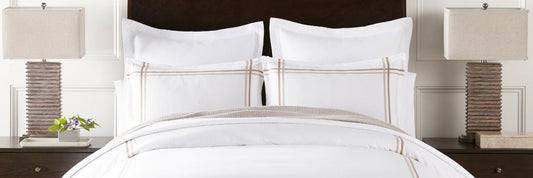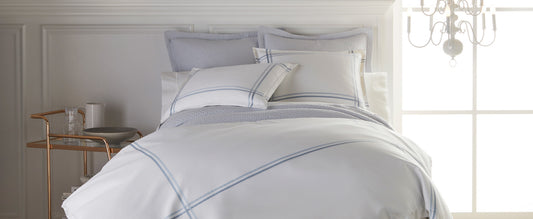A featured product line here at Peacock Alley and a favorite of designers and home decorators alike is our delightful collection of coverlets. In addition to our finely textured signature matelassés, we also offer quilted, garment washed, and tailored pique coverlets. But if you’re not familiar with coverlets or their use, you may find yourself scratching your head about what to do with these beautiful pieces. Read on to find out!

What is a Coverlet?
If you’re unfamiliar with the world of fine linens and luxury bedding design, it wouldn't be surprising if you didn't know what a coverlet is. We're here to help! Simply, a coverlet is a top layer for your bed which is lighter weight than duvets or comforters, and isn’t quite as long as an old-fashioned bedspread. You may have also heard them referred to quilts or bedspreads. They are essentially the same thing with subtle differences.
What is the purpose of a coverlet? Well, they are excellent choices for mild or hot weather climates, or they can easily be layered with heavier pieces when the weather turns colder. They’ll take up less space in your linen closet than a duvet or comforter, so they’re easier to switch out for a change in style. And they’re typically made from heavier textured fabrics that are less likely to wrinkle, so they tend to be an easier care option.
Shop Coverlets & Matelassés

Juliet Matelassé Coverlet

Montauk Matelassé Coverlet

Oxford Matelassé Coverlet

Lucia Matelassé Coverlet
How Should You Style a Coverlet?
In design, coverlets are often used to tame the fluffiness of a down duvet, or to add texture and depth to a bedding ensemble. They can be paired with matching shams or used with coordinating colors for a less formal look.
There are three main ways to make a bed with a coverlet, and depending on your needs, you may want to switch between them depending on the temperature.
First, you can use a coverlet directly over your top sheet, with no added blanket or duvet. This is a classic, clean look and ideally suited for summer’s heat. For a bit of extra color, you may choose to add a bed scarf or a folded blanket to the foot of the bed when it’s not in use.
Next, make the bed as above, but fold your duvet or comforter in thirds at the foot of the bed. This look is wonderful for those spring or autumn months when you’re never quite sure if you might need another layer as temperatures drop during the night.
Finally, you can make your bed with the duvet on top of the sheets, and then place the coverlet over the top. This is excellent for the coldest winter nights, and also a wonderful way to tame the puffiness of a thick and soft duvet into a more sleek and modern look.
No matter how you choose to style your coverlet, we think you’ll find them to be an essential piece for a well-dressed bed!
Coverlet FAQs
Q: What is a coverlet?
A: A coverlet is a lightweight, decorative bed covering that typically falls somewhere between a quilt and a blanket in terms of thickness. It’s primarily used as an additional layer of bedding or as a standalone bedspread.
Q: How is a coverlet different from a quilt, bedspread, or duvet?
A: A coverlet is thinner and lighter than a quilt or duvet. While quilts and duvets are often used for warmth, coverlets are more decorative and typically used for layering.
Q: What materials are coverlets made from?
A: Coverlets are usually made from materials like cotton, linen, or polyester. These fabrics make them breathable, soft, and easy to maintain.
Q: What sizes do coverlets come in?
A: Coverlets are available in all standard bedding sizes, including twin, full/queen, and king.
Q: Can a coverlet replace a duvet or comforter?
A: A coverlet can replace a duvet or comforter in warmer months, as it provides a lighter layer of warmth. In colder months, it’s often layered on top of other bedding for added style and warmth.
Q: How should I style a bed with a coverlet?
A: You can use a coverlet folded at the foot of the bed for a decorative touch or as the primary bed covering with layered sheets and blankets underneath. It can also be paired with coordinating shams for a polished look.
Q: Are coverlets machine washable?
A: Most coverlets are machine washable, but it’s always best to check the care label for specific washing and drying instructions.
Q: What are the benefits of using a coverlet?
A: Coverlets are versatile, lightweight, and decorative. They can add texture, color, or pattern to your bed while providing a comfortable layer of warmth.
Q: When should I use a coverlet instead of a quilt or blanket?
A: A coverlet is ideal for warm weather or when you want a lighter layer on your bed. It’s also a great option for achieving a minimalist or layered look in your bedroom décor.
Q: Can I use a coverlet on its own?
A: Yes, a coverlet can be used on its own as a bedspread, especially in warm climates or seasons when heavier bedding isn’t necessary.

























